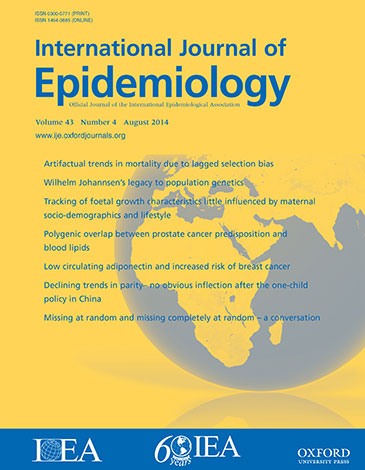Association of age at menarche with type 2 diabetes mellitus among urban Indian women: results from the CARRS study.
IF 5.9
2区 医学
Q1 PUBLIC, ENVIRONMENTAL & OCCUPATIONAL HEALTH
引用次数: 0
Abstract
BACKGROUND Early onset of menarche is associated with hormonal alterations that may predispose women to diabetes. We investigated the association between age at menarche and incident diabetes in India, a setting with declining menarche age and increasing burden of diabetes. METHODS Data were from the Cardiometabolic Risk Reduction in South Asia study. Women free of diabetes at baseline (2010-12) were followed until 2021 for incident diabetes, defined as prior medical diagnosis or fasting plasma glucose ≥126 mg/dl or HbA1c ≥6.5%. Age at menarche, in years was collected through self-report. Multivariable Cox proportional hazards regression models, controlling for socio-demographic factors and potentially confounding clinical parameters, estimated the association [hazard ratio (HR)] of menarche age with incident diabetes. Effect modification by obesity status was also assessed. RESULTS Of 3654 women at risk of diabetes at baseline, mean age was 37.7 [Standard Deviation (SD) = 10.4] years and mean age of menarche was 13.9 (SD = 1.3) years. Younger women (age 20-39 years) had an earlier onset of menarche compared to older women. Over 11 years of follow-up (median: 9.2 years), we observed 390 cases of diabetes [cumulative incidence (CI): 10.7%, 95% CI 9.32-12.33; incidence rate: 12.4 per 1000 person-years (95% CI 11.23-13.69)]. There was no association between age at menarche and incident diabetes, HR = 1.04 (95% CI 0.95-1.14). The null association was consistent in models stratified by obesity status. CONCLUSION We did not find evidence of an association between age at menarche and incident diabetes in this large cohort of Indian women.印度城市妇女月经初潮年龄与2型糖尿病的关系:来自CARRS研究的结果
背景:月经初潮的早发与激素的改变有关,这可能使女性易患糖尿病。我们调查了印度初潮年龄与糖尿病发病率之间的关系,印度初潮年龄下降,糖尿病负担增加。方法数据来自南亚心脏代谢风险降低研究。基线(2010- 2012年)无糖尿病的女性随访至2021年,以确定是否发生糖尿病,定义为既往医学诊断或空腹血糖≥126 mg/dl或HbA1c≥6.5%。初潮年龄,以年为单位,通过自我报告收集。多变量Cox比例风险回归模型,控制了社会人口学因素和可能混淆的临床参数,估计了月经初潮年龄与糖尿病发病率的关联[危险比(HR)]。还评估了肥胖状况对效果的影响。结果3654名基线时有糖尿病风险的女性,平均年龄为37.7[标准差(SD) = 10.4]岁,月经初潮平均年龄为13.9 (SD = 1.3)岁。年轻女性(20-39岁)比老年女性月经初潮更早。在11年的随访中(中位数:9.2年),我们观察到390例糖尿病[累积发病率(CI): 10.7%, 95% CI 9.32-12.33;发病率:12.4 / 1000人-年(95% CI 11.23-13.69)]。初潮年龄与糖尿病发生率无相关性,HR = 1.04 (95% CI 0.95-1.14)。在按肥胖状况分层的模型中,零关联是一致的。结论:在这一大群印度妇女中,我们没有发现月经初潮年龄与糖尿病发病率之间存在关联的证据。
本文章由计算机程序翻译,如有差异,请以英文原文为准。
求助全文
约1分钟内获得全文
求助全文
来源期刊

International journal of epidemiology
医学-公共卫生、环境卫生与职业卫生
CiteScore
13.60
自引率
2.60%
发文量
226
审稿时长
3 months
期刊介绍:
The International Journal of Epidemiology is a vital resource for individuals seeking to stay updated on the latest advancements and emerging trends in the field of epidemiology worldwide.
The journal fosters communication among researchers, educators, and practitioners involved in the study, teaching, and application of epidemiology pertaining to both communicable and non-communicable diseases. It also includes research on health services and medical care.
Furthermore, the journal presents new methodologies in epidemiology and statistics, catering to professionals working in social and preventive medicine. Published six times a year, the International Journal of Epidemiology provides a comprehensive platform for the analysis of data.
Overall, this journal is an indispensable tool for staying informed and connected within the dynamic realm of epidemiology.
 求助内容:
求助内容: 应助结果提醒方式:
应助结果提醒方式:


